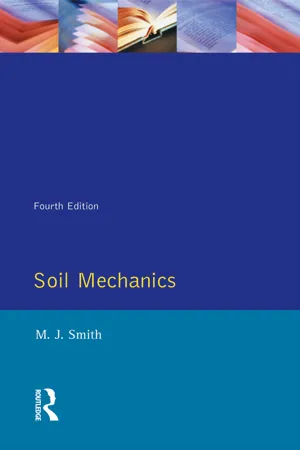
This is a test
- 176 pages
- English
- ePUB (mobile friendly)
- Available on iOS & Android
eBook - ePub
Soil Mechanics
Book details
Book preview
Table of contents
Citations
About This Book
First published in 1989. This series was originally designed as an aid to students studying for technical examinations, the aim of each book being to provide a clear concise guide to the basic principles of the subject, reinforced by worked examples carefully selected to illustrate the text. This book has been prepared with the object both of helping the student pass an examination, and for the practising engineer. The subject-matter of Soil Mechanics, has been restricted to basic principles, and worked examples are selected to give good coverage.
Frequently asked questions
At the moment all of our mobile-responsive ePub books are available to download via the app. Most of our PDFs are also available to download and we're working on making the final remaining ones downloadable now. Learn more here.
Both plans give you full access to the library and all of Perlego’s features. The only differences are the price and subscription period: With the annual plan you’ll save around 30% compared to 12 months on the monthly plan.
We are an online textbook subscription service, where you can get access to an entire online library for less than the price of a single book per month. With over 1 million books across 1000+ topics, we’ve got you covered! Learn more here.
Look out for the read-aloud symbol on your next book to see if you can listen to it. The read-aloud tool reads text aloud for you, highlighting the text as it is being read. You can pause it, speed it up and slow it down. Learn more here.
Yes, you can access Soil Mechanics by Michael John Smith in PDF and/or ePUB format, as well as other popular books in Technology & Engineering & Construction & Architectural Engineering. We have over one million books available in our catalogue for you to explore.
Information
CHAPTER 1
Soil Definitions
Engineering Definition of Soil
For engineering purposes, soil is considered to be any loose sedimentary deposit, such as gravel, sand, silt, clay or a mixture of these materials. It should not be confused with the geological definition of soil, which is the weathered organic material on the surface, or topsoil. Topsoil is generally removed before any engineering projects are carried out.
Voids
Soil is made up of various-sized particles packed together, with the spaces between particles known as voids (see Fig. 1(a)). The voids are generally a mixture of air and water, but in certain circumstances may be completely air or completely water.

FIG. 1. (a) Soil sample, (b) Block diagram. Note symbols used.
Void ratio
The ratio of volume of voids to volume of solids is known as the void ratio.

For convenience it may be assumed that all the solids in a sample can be compressed together and their volume considered equal to unit volume.
This may be shown in a block diagram (see Fig. 1(b)).


Total volume of soil sample V = 1 + e
Porosity
The porosity of a soil is defined as the ratio of volume of voids to total volume of sample.

which, referring to Fig. 1(b), taking Vs = 1 gives

Degree of saturation
The ratio of volume of water to volume of voids is known as the degree of saturation.

or

The voids in soil below the water table should be considered as completely filled with water, in which case the degree of saturation is 1, or the percentage saturation 100 per cent. In fine-grained soils water will rise owing to capillary action between particles, and soil, for a "fringe" height above the water table may become saturated. Even well above the water table there will always be a thin film of water surrounding individual grains of soil. This is known as adsorbed water. Adsorbed water can be removed only by oven-drying the soil, and is of importance in considering cohesion between grains.
Percentage air voids
The ratio of the volume of air to the total volume of soil is known as the percentage air voids.

Moisture Content, Specific Gravity and Density
The methods of determination of the specific gravity of soil particles, the moisture content and bulk density of a soil sample are given in detail in B.S. 1377: 1975 (Methods of testing soils for civil engineering purposes). Only a brief description therefore is given here, and for fuller details the British standard should be referred to.
These three prope...
Table of contents
- Cover
- Title
- Copyright
- Contents
- GENERAL INTRODUCTION
- AUTHOR'S PREFACE
- 1 SOIL DEFINITIONS
- 2 COMPACTION
- 3 SOIL CLASSIFICATION
- 4 PERMEABILITY
- 5 CONSOLIDATION
- 6 SHEAR STRENGTH
- 7 DISTRIBUTION OF VERTICAL PRESSURE
- 8 SOIL PRESSURES ON RETAINING WALLS
- 9 STABILITY OF SLOPES
- 10 FOUNDATIONS
- APPENDIX: Answers to questions
- INDEX